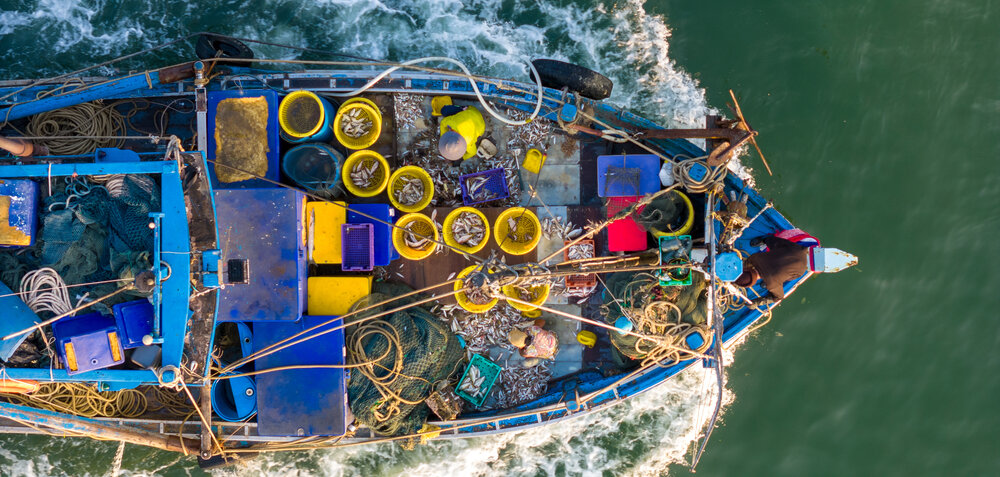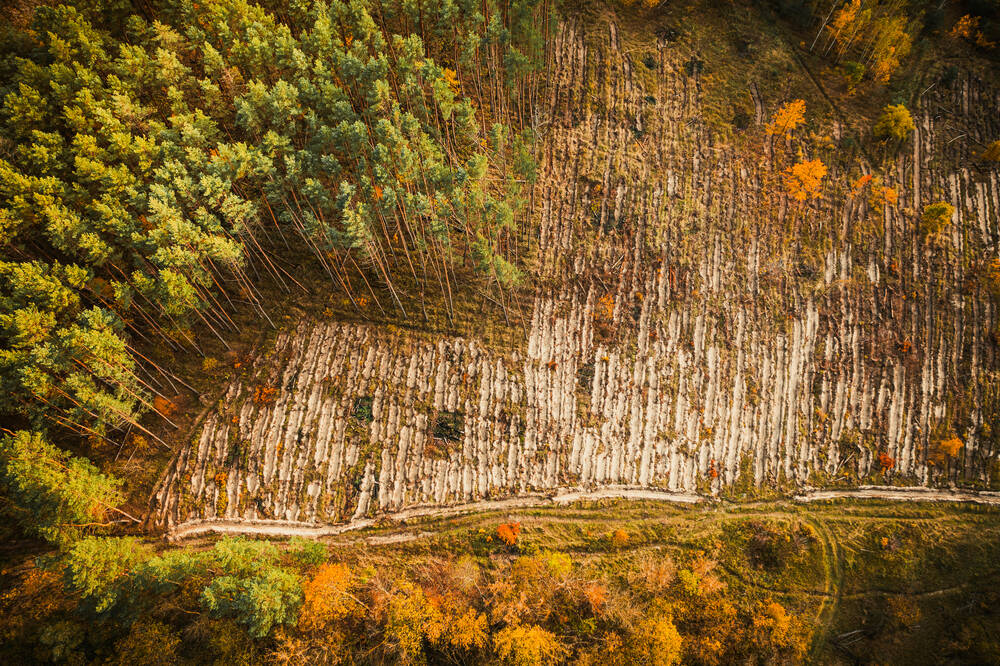Increasing demands for non-renewable resources have led to the widespread exploitation of natural resources. As fossil fuel consumption rises, so do carbon emissions, exacerbating climate change.
Developing countries face significant challenges as they balance economic growth with the environmental impact of resource extraction and overexploitation.
This article covers how humans’ exploitative approach towards nature’s resources, first delving into the most significant examples of exploitation from wildlife poaching to groundwater depletion, then covers the most prominent impacts of these actions.
We highlight human activity as a driver of ecological collapse—and what is being done to support nature’s inability to keep up.
What are Natural Resources?
Natural resources encompass everything from microscopic organisms to the sunlight of day, but can be compartmentalised into four broad categories.
- Renewable resources are those that naturally replenish—so the sun, water, wind, and heat of the Earth, forests, and wildlife. These can be overexploited faster than they are able to regenerate. A tree can take 100 years to grow, but get knocked down in minutes.
- Non-renewables are the planet’s minerals and metals, nuclear fuels and fossil fuels. These tend to be over-extracted in environmentally damaging ways.
- Biotic resources come from any living organisms, so the bark from a tree, animals, and even fossil fuels as they’re formed from ancient organic matter. This is logging, overhunting, and also feeds the illegal wildlife trade.
- Abiotic resources are from non-living sources—such as water, air, minerals and sunlight. Water, soil, minerals and sand are all overexploited for economic purposes.
We will delve into how and why these resources are overexploited to meet surging demands of globalisation, overpopulation, and short-term economic pressures.
What is Overexploitation?
Overexploitation occurs when a natural resource is being depleted at a faster rate than it can be replenished.
The hasty technological advancements of the 1950s such as mechanised farming and industrial fishing not only sped up efficiency across agriculture and food production but made it suddenly easier to over-exploit the planet.
Bright minds and new inventions wowed audiences with unprecedented speeds, however the pace was only to get quicker, leaving us where we are today, catching up with the environmental harm that has been done, trying to make fixes while meeting the soaring economic standards we have set for ourselves.
Types of Overexploitation

Overfishing
While fishing has been around for 40,000 years, it’s only been over-exploitative since the mid-1950s, following the development of industrial fishing technologies.
This primarily includes nets for bottom trawling (nets as big as football fields dragged across the sea floor and catching all), sonar fish finders (locating huge fish schools with precision), and factory ships built for large–scale fishing, freezing and processing capabilities.
The overexploitation and subsequent decline in fish populations can negatively impact the livelihoods of millions of people. In West Africa, communities suffer from losses of jobs, to people’s inability to afford rising fish prices.
Beyond this, overfishing impacts entire food webs, causing shifts in ecosystems, reducing predator populations, and altering marine biodiversity.
Deforestation
Trees simply do not grow back fast enough for the rate we are cutting them down today.
Deforestation is when trees and forests are cut down at a small or large scale for the purposes of agriculture, logging, urbanisation, infrastructure development, resource extraction or other needs. It’s globally recognised as extremely harmful for the environment, as well as displacing indigenous communities and robbing the livelihoods of forest-dependent people.
Forests, woods and trees are some of the strongest carbon dioxide sinks on the planet, and wiping them out causes a huge increase in CO2 levels, enhancing global warming and disruptions in weather patterns. Deforestation obstructs water cycles, leading to further unseen weather changes.
Reforestation is a mitigation strategy, but at times cannot compete. Sustainable forestry practices and conservation programs have administered widespread global efforts to combat deforestation and aid the environment.
Water Overuse
Water overuse can look like excessive irrigation (watering) of agricultural land especially crops like rice, sugarcane and cotton. Surging global demand in line with globalisation calls for the extensive use of water resources to keep needs met. This makes wetland habitats a target, and frequently drained by methods such as canal digging or pumping.
Left drained, the habitats suffer from biodiversity loss and no longer provide essential ecosystem services such as water purification, flood control or carbon storage.
Water is significantly exploited in industrial consumption for processes such as cooling, cleaning, or material processing—a single factory can use millions of litres of water in a month.
Overpopulation leads to increased demand, including baths, showers, hand-washing, toilet-flushing, not to mention food production. Wealthier countries with access to clean water are especially wasteful.
Soil Degradation
Overexploitation contributes to degraded soils from deforestation, overgrazing, and exploitative activities like widespread mining.
For instance, traditional farming is effective at creating short-term, high-profit yields of ecologically-modified crops; however it is drastically harmful to nature in the long term.
In traditional farming, growing the same monoculture on one field each year hugely reduces biodiversity, leading to eroded soils, disease and pest risk, and potential dependencies on synthetic inputs.
Shallow roots fail to break up the soil, and heavy machinery can compress it down. This results in less access for water, meaning less growth of roots.
Mining and Extraction
Technological advancements have led to immensely efficient mining techniques. From the straightforward pick-and-shovel systems in early mining eras, today’s tech boasts automated drills and explosives capable of accessing deep ore bodies.
The majority of deforestation for mining is in pursuit of gold and coal, and is a heavy contributor globally. Accessing large mineral deposits can require large areas of land, requiring the removal of tracts of forests, making room for processing plants, access roads, excavation pits or waste disposal areas.
This pollutes the forest, such as dumping waste on the forest floor, harming the vegetation and habitat. The mining activities can further disturb the soil, eroding and degrading the land, in turn making it harder for the forests to regrow and regenerate.
As their excavations and successes develop, so does the land area, meaning more and more of the forest is wiped out as the natural resources are extracted.
Fossil Fuel Consumption
Fossil fuels are finite. At the rate we touched them 100 years ago, they could have lasted us another 500 years, but at the rate we’re hacking away at them today, they could run out by the end of this century. Ideally they won’t—their continued use undermines climate stability, ecosystems, and long-term human health.
To stay below 1.5°C, scientists suggest that 60% of global oil and gas reserves would have to stay in the ground in 2050.
Wildlife Poaching
Wildlife poaching involves harvesting masses of wild animal populations, usually for traditional medicine, luxury goods, and the exotic pet trade. The rates of removal are much higher than naturally replenished, especially when niche-traited animals are the target such as tusked or horned.
Poaching is entirely illegal, though as an industry has more success than many conservation efforts. It’s unregulated, meaning that poachers can get away with vile cruelty on a mass scale. It’s most prominent in areas like sub-Saharan Africa and Southeast Asia, where biodiverse ecosystems are rich in high-value species and enforcement is often under-resourced.
Urban Expansion
Urban expansion and the growth of cities demand housing for more people, space for more intensive agriculture, infrastructure, and industry. It’s a catch-22 of cities developing, appealing to more people, then needing to expand further to accommodate them.
This leads to an overexploitation of soil, water, energy, and food, plus habitats are wiped out.
Nature struggles to keep up with this. London, for instance, has developed from a compact city of under a million in the early 1800s to a sprawling metropolis of nearly 10 million today—meaning that vast areas of natural land have been permanently lost and more so continues to disappear.
Industrial Agriculture
Industrial agriculture utilises technological advancements to take short-term yields but leaves long-term environmental damage.
In regenerative farming, new techniques replace outdated methods to ensure soil fertility—such as cover cropping (plants grown between the cycles) or perennial planting (plants that live for multiple years for soil erosion).
Beyond farming, a poignant example of overexploitation here are CAFOs (Concentrated Animal Feeding Operations) which can house millions of animals in confined spaces involving painful mutilations and mass murder.
Groundwater Depletion
Groundwater sources are water that’s been stored in aquifers, filling spaces underground like pores and fractures. Over extended periods the rain and surface water seep through soils, collecting where it can underground.
This results in varying depths depending on differing geological conditions—as deep as 1,000 metres in arid regions, whereas more shallow in the humid lowlands.
Groundwater sources are being overexploited for domestic and municipal supplies, industrial usage, plus are excessively pumped for agriculture.
This excessive usage can lead to land subsidence, where the ground physically sinks, and at times drying of the wells and springs.
Overgrazing
Grazing is when livestock in a pasture feed on the tops of plants without damaging the roots. This maintains a food system and source for wildlife, sustains soil fertility and ensures long-term productivity, as land can be reused continuously while remaining healthy.
Overgrazing occurs when livestock such as cows, goats, or sheep are forced to graze for too long, resulting in lost essential topsoil, lost vegetation cover, and drops in nutrient levels.
As a solution, managed or rotational grazing involves strategically controlling where the animals graze. This gives the plants time to recover instead of overworking the soil, ensuring it maintains its structure and fertility. While this is common in regenerative farming, overgrazing remains the norm.
Habitat Destruction
Overexploitation takes many shapes and forms, and almost all of them end in habitat destruction. Whether land conversion for agriculture, resource depletion for economic flows, or soil degradation for overgrazing, habitats across the globe are hit.
Some animal species rely on individual trees for nesting, shelter, or food—while deforestation can result in the loss of hundreds of thousands of hectares of forest at once.
Remaining habitats can be left fragmented, with fewer habitats in isolated patches, separated by dangerous barriers such as busy roads with traffic that some fauna will struggle to safely cross just to access their water source.
These cases of overexploitation disrupt essential ecosystem services that would have contributed to a healthy, thriving ecosystem beforehand, as well as essential water cycles that animals are dependent on for local water availability.
The Impact of Overexploitation on Biodiversity

Biodiversity Loss
Technology has led to humans depleting natural resources faster than they can replenish. As a result, economies are booming across the globe, but ecosystems are collapsing.
Alarming biodiversity loss is one of the most dire and concerning results of overexploitation. A shocking 69 per cent of the planet’s biodiversity has gone in just 50 years, largely fuelled by the industrial revolution.
Primary targets here are deforestation, overfishing, and overgrazing—efforts must be made now to restore balance and protect remaining ecosystems.
Habitat Destruction
Habitats provide everything from food, shelter and all in between.
Forests provide timber, oxygen, and carbon storage, while the space they leave makes way for agriculture and development.
Savannas and grasslands are frequently converted into agriculture or overgrazed by livestock, turning them from buzzing ecosystems to barren landscapes—and dropping their ecological value to near zero.
Wetlands are drained, leaving them dry and fragile, needing decades for sufficient restoration, and bodies of water are overfished, polluted from industrial runoff, converted into dams—few of these leaving room for the rich biodiverse capabilities they held before.
Species Decline and Extinction
An unfortunate result of overexploitation is the decline of the majority of species.
In marine life, Great Whites and Hammerheads are targeted for their fins, whereas Bluefin Tuna has a market value up to millions of dollars due to its use in high-end sushi and sashimi.
Unique traits like these are the target of illegal hunting and trade across mammals, birds, reptiles, amphibians, even invertebrates and plants (giant clams in luxury decor; Ginseng for traditional medicine).
Extinction was a far and wide occurrence centuries ago, but today, it happens at an accelerated rate.
Disruption of Ecosystem Balance
Exploiting something is fine, but exploiting it to the point of disrupting the harmonious (and essential) ecosystem services provided by its environment is problematic. This is seen significantly in overfishing, overgrazing, deforestation, and unsustainable hunting.
The tipping point marks the shift from sustainable exploitation to environmental degradation, where nature’s ability to provide essential ecosystem services weakens.
‘Ecosystem services’ encompass any positive benefit from wildlife or ecosystems provided to people. This could be climate regulation, water purification, soil fertility, food and fuel, or pollination.
Loss of Genetic Diversity
Genetic biodiversity refers to the variety of genes in a population or species, encompassing ranges of gene combinations, alleles, and sequences of DNA.
The higher the genetic biodiversity, the higher the ecosystem health and resilience, crucial for a species’ adaptability to new environmental changes like pollution, climate change, or invasive species.
Due to overexploitation, isolated habitats lead to reduced gene flows, increased inbreeding within fragmented populations, and losses of rare alleles which prepare the population for environmental changes and disease outbreaks such as pathogen resistance decline.
With global warming, external challenges like extreme weather events and emerging diseases are on the rise, meaning ecosystems need to be more resilient than ever. Due to overexploitation to meet the unprecedented needs of urbanisation, they could be failing to keep up until real changes are made.
Invasive Species Proliferation
The overexploitation of certain animals for traditional medicine, ornamental purposes or as pets is a significant driver of invasive species.
The global wildlife trade is immense, and creates intentional pathways of non-natives that disrupt ecosystems and outcompete natives. An example of this is the Red-eared Slider turtle, native to the US but now outcompeting native turtles for food, basking and nesting in areas such as Southeast Asia and parts of Europe.
Moreover, rarer plant species can be over-collected, leading to their escape into non-native environments, becoming weeds that fight for the available resources. This disrupts ecosystems as chains lose their natural order, causing collapse, which might look like widespread diseases or population crashes in native species.
What Can Be Done?
Many efforts are in place to counteract the negative impacts of overexploitation.
Conservation groups, environmental NGOs and government agencies lobby for stronger environmental protections and better policies and regulations for resource management and wildlife protection.
Reforestation initiatives are taking place across the planet, specifically in areas like the Amazon rainforest, where the pace of deforestation is alarming.
Circular economies counteract overexploitation by reducing waste and reusing resources, not exploiting new raw materials. Refurbishing a tired wardrobe instead of disposing of it, for instance, could save multiple trees from the lumber industry.
Sustainable practices are essential for ensuring the survival of ecosystems and species.
More Information
https://www.nationalgeographic.com/environment/article/critical-issues-overfishing
https://www.clientearth.org/latest/news/we-are-challenging-the-eu-to-end-overfishing
https://earthobservatory.nasa.gov/features/Deforestation/deforestation_update3.php
https://www.undrr.org/understanding-disaster-risk/terminology/hips/en0009
https://news.ucsb.edu/2024/021303/global-groundwater-depletion-accelerating-not-inevitable

